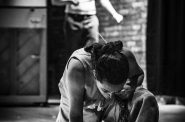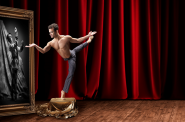Duquesne Tamburitzans
Generations of students have made the Duquesne University Tamburitzans the longest-running live stage show in the country. For 74 years, the ensemble has presented the song and dance of a many East European cultures, but Croatia is the center of their world. The Tamburitzans mean a lot to us Croatian Americans; when the Pittsburgh- based Tamburitzans played at Greendale High School on March 27, my family was there.
I realize now why this annual show is not to be missed.
The dancers entered wearing beautiful, handmade garb customary not only to countries but to specific regions. Intricate embroidery, detailed headdresses and coined necklaces that jingle as their wearers dance embellish the authentic designs. Each costume relates to the song and dance and helps define the culture of each country.
The show alternated large group ensembles, character dancing and instrumentals.
A folk orchestra, with instruments specific to regions and countries, accompanied.
Native instruments were strummed, picked, and beaten. We heard everything from the distinct sounds of a Slovakian flute to dueling Macedonian drums to the guitar-like tamburitza, the national instrument of Croatia. Complex rhythms and high energy dancing are the norms in this part of the world.
Dancers formed and dissolved geometric designs as they glided or stomped across the floor. Lines of them coiled into rings that spun rapidly. The men make an impression by standing on each other’s shoulders and leaping through the air.
They clap their hands and slap their bodies in aggressive rhythms. From the Croatian Kolo to the Bavarian Waltz to the Bohemian Polka, dancers showed off explosive thrust, intricate movement and lightning footwork.
The Tamburitzans sing in many languages and dialects, but literal understanding is beside the point. The essence lies in the authenticity and tradition, in songs and dances that transcend cultural divides. The Tamburitzans celebrated many cultures, but especially my own. And they made me proud.
Dance
-
New Riverwest Company, Production Impresses
 Feb 10th, 2020 by Brendan Fox
Feb 10th, 2020 by Brendan Fox
-
Milwaukee Ballet Show Remakes History
 Feb 10th, 2020 by Catherine Jozwik
Feb 10th, 2020 by Catherine Jozwik
-
Ballet Does Free Production of ‘Nutcracker’
 Dec 20th, 2019 by Richard Davis
Dec 20th, 2019 by Richard Davis






















